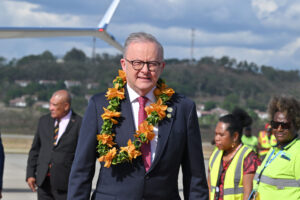By Richie Merzian, Director of The Australia Institute’s Climate & Energy Program.
[Read article in the New Matilda Here]
Private and public investment in a safe climate future is growing, despite the best and worst efforts of some of the world’s leading polluters, writes Richie Merzian.
On a reclaimed swamp fringing the outskirts of the industrial city of Incheon in the Republic of Korea you’ll find the G-Tower, home of the Green Climate Fund (GCF). While this purpose-built town is an odd choice for the headquarters of the world’s largest climate fund it is typical of the UN decision-making that defines how the GCF works.
The GCF Board has 24 members split evenly between ‘developed countries’ (mainly OECD members) and ‘developing countries’ (mainly non-OECD members) and every decision, from approving the Secretariat’s pay-scale to billion dollar investments to the location of fund headquarters, has to be by consensus. Climate finance is all about balance and fairness, allowing industrialised countries that have benefited from high greenhouse gas economies to help finance efforts by poorer countries to cut their emissions and adapt to climate change.
Last week, the GCF Board held its 20th meeting and took two days to agree an agenda, failed to consider funding proposals and received the resignation of the Executive Director of the GCF Secretariat. Without background, it sounds like the GCF is in free-fall and Australia should question its AU$200 million investment, especially after American President Donald Trump announced the US would not honour its remaining US$2 billion GCF pledge.
In truth, the GCF has been a major asset for Australia and the international community, by supporting climate action in vulnerable island countries and levering corporate finance for climate change. Australia has been highly influential in the fund, co-chairing the GCF Board for three of the last six years, including overseeing a period of rapid growth in 2016 and 2017. In that two-year window, the GCF Board agreed – by consensus – to invest in 46 projects totalling US$2.5 billion. Just in our region, eight Pacific island countries succeeded in attracting over US$300 million in GCF investments in renewable energy and climate resilience – more than the entire Australian contribution to the GCF.
But it’s through the GCF’s Private Sector Facility that the greatest impact can be made. For example, the GCF’s US$250 million investment in the European Investment Bank’s Global Energy Efficiency and Renewable Energy Fund will mobilise US$30 billion in renewable energy and energy efficiency in emerging markets. That’s a leverage ratio of 120. One of the largest private investors in the project is an Australian superannuation fund.
The Paris Agreement is built on the understanding that climate finance must come from all funding sources. The goal of raising US$100 billion per annum by 2020, agreed at the Copenhagen conference, should come from both governments and private sources. Furthermore, the GCF is only one of many climate finance vehicles and is not expected to fundraise the US$100 billion. According to the Climate Policy Initiative, that tracks global climate finance, around 65 per cent is currently from private sources.
The recent resignation of the Executive Director of the GCF, former Australian climate envoy Howard Bamsey, seems to be timed to recruit a replacement ahead of the GCF’s first replenishment process, where it will seek to top up its finance. Mr Bamsey has been instrumental in strengthening the fund, has doubled the size of the GCF Secretariat and took the prudent step of creating and filling a Deputy Executive Director position late last year. Two weeks ago, the GCF’s sister fund, the Global Environment Facility concluded a successful replenishment process, including additional funding from the US, demonstrating the appetite of donors to contribute to these important climate funds.
The Paris Agreement marked the turning point in the direction of climate finance. The Climate Policy Initiative maintains that average annual climate investment from all countries in 2015 and 2016 is US$410 billion. Just last week in Paris, the sovereign wealth funds of Kuwait, Norway, New Zealand, Qatar, Saudi Arabia, and the United Arab Emirates – many fuelled by oil and gas revenue and collectively worth over US$3 trillion – pledged to put climate change front and centre in their investments.
The US President’s call to cancel its climate finance pledge is an outlier, not the norm and Australia would be poorly served to follow suit. As we all know when it comes to climate change – you shouldn’t rely on outliers – its all about the trend.
Between the Lines Newsletter
The biggest stories and the best analysis from the team at the Australia Institute, delivered to your inbox every fortnight.
You might also like
Pacific nations have just delivered Australia two smackdowns. That’s a big deal.
We need to talk about the Pacific.
Neighbour from hell – A Pacific plea to Anthony Albanese and Peter Dutton
A group of Pacific Island Elders, including two former leaders, have written an open letter to Australian Prime Minister Anthony Albanese and Opposition Leader Peter Dutton, urging them to stop approving new fossil fuel projects.
Labor giving billion-dollar cost of COP to Pacific would show genuine climate leadership
The Australia Institute is calling on the Albanese Government to redirect the billion dollars saved by not hosting COP31 to Pacific nations.


